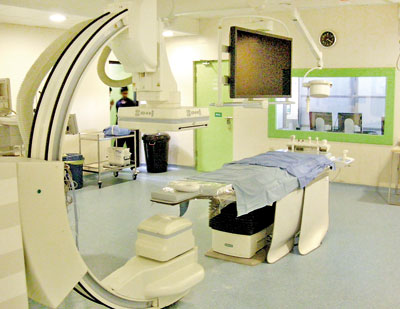A one-stop brain centre opens its doors
For the first time a fully dedicated Stroke Unit in a private hospital.
The heart is looked after by many a private hospital, but what of the brain? Seeing the lacuna in the urgent and vital treatment of “brain attacks” as opposed to heart attacks in the private sector, the Central Hospital is making ready to open its doors wide to victims of stroke.

The Bi-plane DSA Unit at the Central Hospital. Pix by Athula Devapriya
Having the advantage of Specialist Physician Dr. Thurul Attygalle who has specialised in Stroke Medicine and Consultant Interventional Radiologist, Dr. Lakmalie Paranahewa working in tandem, the facilities and other personnel are already in place to give care to stroke victims, the Sunday Times learns.
We will seek the guidance of top Neurologists and Neurosurgeons in the treatment and management of stroke patients, said Dr. Attygalle, stressing that for the best outcome the patient should come under the care of a multidisciplinary team. This will be the first-ever fully dedicated Stroke Unit in a private hospital, says Asiri Group Director of Medical Services, Dr. Manjula Karunaratne explaining that it will be ‘a one-stop brain centre’.
The Stroke Unit is equipped with state-of-the-art technology including advanced investigation facilities and the Bi-plane Digital Subtraction Angiography (DSA) Unit for neuro-procedures, a first in the country, it is learnt. These facilities will ensure accurate diagnosis and treatment to be tailored to deal with specific complications.
Dedicated in-house medical professionals will be on standby round-the-clock to tackle any emergency or complication related to stroke. Preventive and rehabilitative therapies are also available to avert post-stroke complications and facilitate the expeditious rehabilitation of patients, Dr. Attygalle said.
Referring to the “pathway” being created for expert care in the private health sector, he said that when a person suffers a stroke, anyone who recognizes the symptoms should call the Central Hospital’s hotline. The hospital would then instruct the ambulance service that it coordinates with to rush to where the patient is, stabilize him and then bring him to hospital where the medical team awaits his arrival at the emergency unit. The delivery team which brings the patient would have carried out an initial assessment, collected all the information and alerted the medical team.
Thereafter, acute stroke care would be provided to reverse or prevent damage to the brain. Next would follow rehabilitation, as required, explains Dr. Attygalle. Patients can also be brought in directly to hospital, he said.
The ambulance service that Central Hospital has negotiated with is expected to cover a “catchment” area from Ja-ela to Ratmalana including the coastal belt in-between and also up to Thalawathugoda. With ambulances located at different points, once a stroke call comes in, an ambulance would attempt to reach the patient within 15 minutes and deliver him to the Central Hospital within the hour, depending on the distance, it is understood.
With the paperwork already in hand, having been done on the way, the patient would be rushed through for a CT scan to determine whether it is an ‘ischaemic’ or ‘haemorrhagic’ stroke (see box). The treatment, be it clot-busting medication or clot-retrieval, depending on the need, would be decided thereafter, the Sunday Times learns.
Clot-retrieval, the delicate minimally-invasive interventional radiological procedure, comes under the mandate of Dr. Paranahewa who says that the Bi-plane DSA facility helps improve accuracy and speed tremendously. Stroke protocols have been drilled into the staff, adds Dr. Karunaratne, “to give the best care to stroke patients to beat the disabilities which come with stroke”.
Spotting a stroke
A side of the mouth drooping, difficulty in moving an arm or leg on one side of the body or difficulty in speaking and slurring of speech are signs of an onset of a stroke, says Dr. Attygalle. The two main causes of stroke are a blockage due to a clot in a blood vessel which cuts off the blood flow to the brain or when high pressure in a blood vessel makes it burst and bleed into the brain. The first type is an ‘ischaemic’ stroke and affects more than 80% while the second type is a ‘haemorrhagic’ stroke that affects about 15% of those who suffer strokes, the Sunday Times understands.
According to Dr. Attygalle the interruption of the blood supply could cause permanent brain damage unless treated fast, as nearly 2 million nerve cells would die every minute after a block occurs.
Stressing the importance of speed and accuracy of treatment for successful recovery, he points out that the golden window of opportunity for treatment to reverse the impact of stroke and ward off permanent brain damage is 4½ hours. If the patient is able to get treatment in 90 minutes the chances of successful recovery are greater.
Otherwise, there could be life-long disabilities including paralysis, adds Dr. Attygalle.
Follow @timesonlinelk
comments powered by Disqus


